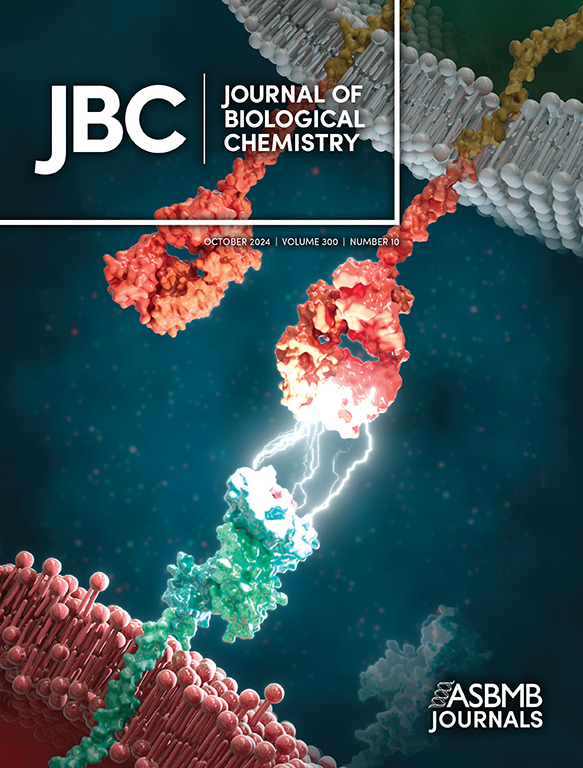Leber's hereditary optic neuropathy-associated ND1 3733G> C mutation ameliorates the mitochondrial quality control and cellular homeostasis.
IF 4
2区 生物学
Q2 BIOCHEMISTRY & MOLECULAR BIOLOGY
引用次数: 0
Abstract
Leber's hereditary optic neuropathy (LHON) is a paradigm for mitochondrial retinopathy due to mitochondrial DNA (mtDNA) mutations. However, the mechanism underlying LHON-linked mtDNA mutations, especially their impact on mitochondrial and cellular integrity, is not well understood. Recently, the ND1 3733G>C (p.E143Q) mutation was identified in three Chinese pedigrees with suggestively maternal inheritance of LHON. In this study, we investigated the pathogenic mechanism of m.3733G>C mutation using cybrids generated by fusing mtDNA-less ρ0 cells with enucleated cells from a Chinese patient carrying the m.3733G>C mutation and control subject. Molecular dynamics simulations showed that p.E143Q mutation destabilized these interactions between residues E143 and S110/Y114, or between S141 and W290 in the ND1. Its impact of ND1 structure and function was further evidenced by reduced levels of ND1 in mutant cells. The m.3733G>C mutation caused defective assembly and activity of complex I, respiratory deficiency, diminished mitochondrial ATP production, and increased production of mitochondrial ROS in the mutant cybrids carrying the m.3733G>C mutation. These mitochondrial dysfunctions regulated mitochondrial quality control via mitochondrial dynamics and mitophagy. The m.3733G>C mutation-induced dysfunction yielded elevating mitochondrial localization of DRP1, decreasing network connectivity and increasing fission with abnormal morphologies. Furthermore, the m.3733G>C mutation downregulated ubiquitin-dependent mitophagy pathway, evidenced by decreasing the levels of Parkin and Pink, but not ubiquitin-independent mitophagy pathway. The m.3733G>C mutation-induced deficiencies reshaped the cellular homeostasis via impairing autophagy process and promoting intrinsic apoptosis. Our findings provide new insights into pathophysiology of LHON arising from the m.3733G>C mutation-induced mitochondrial dysfunctions and reprograming organellular and cellular homeostasis.Leber's遗传性视神经病变相关ND1 3733G> C突变改善线粒体质量控制和细胞稳态。
Leber's遗传性视神经病变(LHON)是一种由线粒体DNA (mtDNA)突变引起的线粒体视网膜病变的范例。然而,LHON-linked mtDNA突变的机制,特别是它们对线粒体和细胞完整性的影响,尚不清楚。最近,在三个中国家系中发现了ND1 3733G>C (p.E143Q)突变,提示母体遗传LHON。在本研究中,我们利用mtdna缺失的细胞与携带m.3733G>C突变的中国患者和对照者的去核细胞融合产生的杂交体,研究了m.3733G>C突变的致病机制。分子动力学模拟表明,p.E143Q突变破坏了ND1中E143和S110/Y114残基之间或S141和W290之间的相互作用。突变细胞中ND1水平的降低进一步证明了其对ND1结构和功能的影响。在携带m.3733G>C突变的突变体中,m.3733G>C突变导致复合物I的组装和活性缺陷、呼吸缺陷、线粒体ATP产生减少和线粒体ROS产生增加。这些线粒体功能障碍通过线粒体动力学和线粒体自噬调节线粒体质量控制。m.3733G>C突变诱导的功能障碍导致DRP1的线粒体定位升高,网络连通性降低,裂变增加,形态异常。此外,m.3733G>C突变下调泛素依赖性的线粒体自噬途径,表现为Parkin和Pink水平的降低,但不影响泛素非依赖性的线粒体自噬途径。m.3733G>C突变诱导的缺陷通过损害自噬过程和促进内在凋亡来重塑细胞稳态。我们的研究结果为m3733g >C突变引起的线粒体功能障碍和重编程器官细胞和细胞稳态引起的LHON的病理生理学提供了新的见解。
本文章由计算机程序翻译,如有差异,请以英文原文为准。
求助全文
约1分钟内获得全文
求助全文
来源期刊

Journal of Biological Chemistry
Biochemistry, Genetics and Molecular Biology-Biochemistry
自引率
4.20%
发文量
1233
期刊介绍:
The Journal of Biological Chemistry welcomes high-quality science that seeks to elucidate the molecular and cellular basis of biological processes. Papers published in JBC can therefore fall under the umbrellas of not only biological chemistry, chemical biology, or biochemistry, but also allied disciplines such as biophysics, systems biology, RNA biology, immunology, microbiology, neurobiology, epigenetics, computational biology, ’omics, and many more. The outcome of our focus on papers that contribute novel and important mechanistic insights, rather than on a particular topic area, is that JBC is truly a melting pot for scientists across disciplines. In addition, JBC welcomes papers that describe methods that will help scientists push their biochemical inquiries forward and resources that will be of use to the research community.
 求助内容:
求助内容: 应助结果提醒方式:
应助结果提醒方式:


